Phoenix IBS SC/I-T and IBS SC/RI/RT-LK
The IBS ISA SC-I/T is an InterBus-S master card.
The IBS ISA SC-I/T DPRAM (MPM) is 4 Kbytes. There are no interrupts used.
Context menu
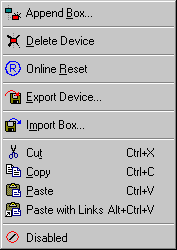
Append Box... <Insert>
Adds InterBus nodes ("boxes"). For an Overview of all currently supported Interbus devices, please see...
Delete Device... <Del>
Removes the IBS ISA SC-I/T fieldbus card and all subsidiary elements from the I/O configuration.
Online Reset
Initiates an online reset on the InterBus-S. The card is then set to RUN mode (see Bus Controller).
"IBS ISA SC-I/T "and "IBS ISA SC/RI/RT-LK" tab
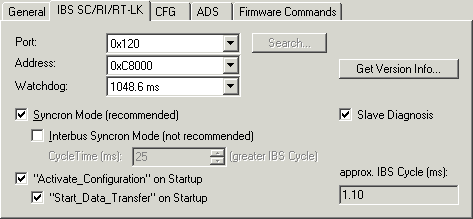
Address: Enter the DPRAM card address here. This address can assume the following values: from 0xC8000 to 0xEF000 in steps of 0x1000
Port: Enter the card port address here. This address is jumped on the card and can assume the following values: from 0x100 to 0x3F8 in steps of 0x8
IBS cycle: The run-time of the Interbus is calculated approximately based on the configured devices and displayed.
Synchronous Mode: The highest priority task linked with the corresponding device controls the fieldbus cycle and is thereby synchronized with the fieldbus. All other tasks are served asynchronously via corresponding buffers.
"Activate_Configuration" at StartUp: Activates the loaded configuration during the TwinCAT StartUp phase (standard setting). Can be disabled if other firmware services are to be accessed before StartUp (see System Start with Incomplete Configuration).
"Start_Data_Transfer" at StartUp: Starts cyclical data transfer in the Interbus at the TwinCAT system start.
Read Bus Configuration: Activates loading of current Interbus device configuration, provided that a TwinCAT configuration is started in which no devices have been configured under the Interbus master card!
- Up to TwinCAT 2.9 Build <= 1000: TwinCAT system reports an error message (0 boxes configured and x boxes awaited). The ”Read Bus Configuration” button is then enabled. This will display the previously recognised configuration in the tree.
- Since TwinCAT 2.9 Build > 1000: Start TwinCAT system in config mode. Select "Reload I/O Devices" and "Scan Sub Devices".
Slave Diagnosis: Option available for system coupler only (Masters with slave interface). If seleceted, the process data provides additional two input words: SlaveDiag and SlaveDiagPara.
Read Firmware Version: Reads the firmware version of the card via firmware service "Get_Version_Info" (see card‘s user manual).
 | For newer motherboards/BIOS, it may be necessary to reserve the DPRAM area which the card will use in the computer BIOS. The corresponding setting is generally carried out in PNP-BIOS and is described as ISA Memblock. |
”CFG” tab
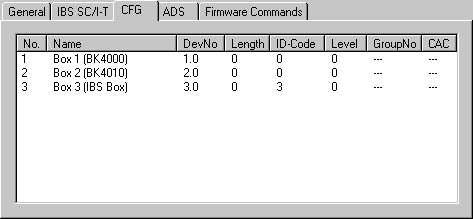
Lists the configuration framework produced based on the configured devices and which is loaded into the card at the system StartUp. Serves as an overview, particularly when the configuration is to be influenced at the run-time via ADS.
Firmware services
Nearly all SC/I-T firmware services can be accessed via ADS by each TwinCAT program. For this purpose, you need to assign an AMS port to the SC/I-T. This port is activated on the ”ADS” tab. The port number is specified as 0x7000 + the ID of the SC/I-T. Otherwise a PLC library is offered which gives the essential Firmware Services for Bus Control in a simple user form.
”ADS” tab
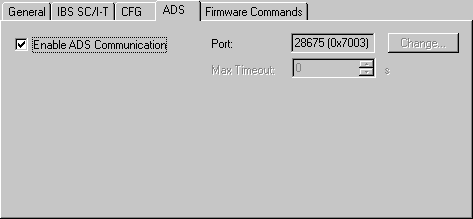
Use AdsReadWriteReq (see ADS documentation) to display the services in the following form:
IndexGroup = 0x00010001
IndexOffset = firmware service code (e.g. 0x00000713 for Control_Active_Configuration)
The number of parameters is determined automatically using Write data. The Write data are not converted by the TwinCAT into Motorola format. The user must do this if required.
The result (confirmation) of the firmware service is returned in Read data.
Example: Switching off a device while bus is in operation
The device with the logical device number 3.1 should be switched off while the bus is in operation:
IndexGroup: 0x00010001
IndexOffset: 0x00000713 (Control_Active_Configuration)
Write Data:
Word 0 0x0200 (device_Off in Motorola Format)
Word 1 0x0100 (entry in Motorola Format)
Word 2 0x0103 (3.1 in Motorola Format)
The Write length is 6 bytes so that the firmware of the Parameter_Count 3 (words) is provided.
Confirmation:
Positive confirmation is as follows:
Read Data:
Word 0 0x0000
Negative confirmation is as follows:
Read Data:
Word 0 0xXXXX (result in Motorola Format)
Word 1 0xXXXX (Add_Err_Info Motorola Format)
”Firmware Commands” tab
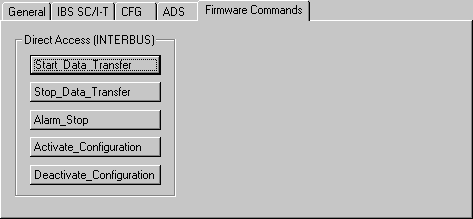
Allows typical firmware bus control commands to be triggered via ADS (providing that an ADS port has been selected).
Bus Control
The bus controller can be influenced with the above firmware services as illustrated below:
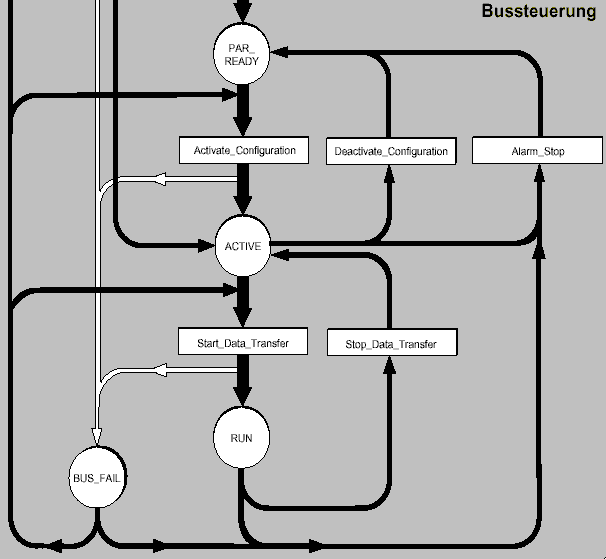
Status indicates the current card status.
- State & 0x00E0 == 0x0080 -> PAR_READY
- State & 0x00E0 == 0x00C0 -> ACTIVE
- State & 0x00E0 == 0x00E0 -> RUN
Input Diagnosis

The IBS ISA SC-I/T automatically provides two input words whose bits describe the status of the card and the Interbus:
State: 0x0001 = user error
0x0002 = periphery error
0x0004 = bus error
0x0008 = hardware error(interface module)
0x0010 = diagnostic routine active
0x0020 = data transfer active
0x0040 = selected configuration is ready to operate
0x0080 = interface module is ready to operate
0x0100 = bus segment is switched off
0x0200 = disable command output
0x0400 = standard function negative
0x0800 = synchronisation error occurred
0x1000 = data cycle malfunction
0x2000 = pre-set waiting period exceeded
0x4000 = pre-set error density exceeded
0x8000 = signal to controller present
DiagPara: The content depends upon the contents of State.
- If 0x0001 or 0x0008 bit is set, the error code is shown in DiagPara.
- If 0x0002 or 0x0004 bit is set, the segment address of the error location is shown in DiagPara.
See firmware Reference Manual IBS SYS FW G4 LIB UM (item no.: 27 45 13 0) under function GetIBSDiagnostic.
Available only for Masters with slave interface (System coupler).
SlaveState:
0x0001 = Slave data transfer. The slave is in data exchange mode.
0x0002 = Fail. Slave reports modul error.
0x0004 = Slave initialized.
0x0008 = Power on. The external voltage is ok.
0x0010 = Ready. Slave is in READY state.
SlaveDiagPara: The content depends upon the contents of SlaveState.
System StartUp with Incomplete Configuration
System StartUp with Incomplete Configuration
If you wish the system to start with incomplete configuration you have several options:
- Alternative Definition: If the potentially unavailable devices are assigned an alternative, they will be disabled when the system is started (this can only take place if deliberately activated using Control_Active_Configuration (see. "InterBus-S” tab for that device)).
- Special Device Settings: A Control_Active_Configuration command can be defined for individual devices. This will be executed before activating the configuration (see "InterBus-S Tab” for that device). Note that a Control_Active_Configuration command will affect subsidiary devices!
- Special configuration during system StartUp by the PLC: You can tell the card to switch on in PAR_READY mode at the system StartUp and have further configuration and bus control carried out by the PLC. In this case proceed as follows:
- Deselect automatic "Active_Configuration". This will leave the card in PAR_READY state
- After the system start, you can individually deselect those devices which you do not require or use a Group Definition (Control_Active_Configuration), so that only remaining (present) devices are activated. De-selection (switching off selected devices) is generally carried out from the PLC via ADS. You can link in the PLC library "PlcIbsScit.lib" to view the necessary ADS commands in the form of options.
- Actuate "Active_Configuration" via ADS
- Actuate "Start_Data_Transfer" via ADS
If you later wish to reactivate the inactive devices, use also "Control_Active_Configuration" via ADS when the system is in RUN mode.
ISA IBS SC/RI/RT-LK Slave Interface (System Coupler)
The slave interface is configured by the higher level INTERBUS system. The process data length of the slave interface can be configured and has a maximum length of 10 words. When the IBS SC/RI/RT-LK is added to the I/O configuration, the process data length of the system coupler is set to 10 words, and the parameter channel data length to 0 bits (no PCP). The INTERBUS interfaces of the IBS SC/RI/RT-LK are translated by a medium converter from copper to optical fibre transmission. The medium converter has ID code 0x08 and length code 0x0. It is added automatically by the System Manager to the card's I/O configuration. Do not initiate operation of the higher level INTERBUS system until the system coupler has the final configuration, since configuration changes will put the higher level system into an error state.

The process data length and parameter channel length of the system coupler can be configured via the slave's context menu commands. The slave's context menu can be opened by clicking with the right mouse button on the slave in the tree of I/O devices.

The maximum possible length for the process data channel depends on the length chosen for the parameter channel. The process data length of 10 words can only be configured after the parameter channel has been deactivated. The system coupler's ID code is generated from the chosen length of the parameter channel, and can adopt the following values:
- ID code 3: no PCP, maximum process data length 10 words.
- ID code 235: parameter channel length 1 word, maximum process data length 9 words.
- ID code 232: parameter channel length 2 words, maximum process data length 8 words.
- ID code 233: parameter channel length 4 words, maximum process data length 6 words.

The system coupler can be supplied with an external voltage so that data can still continue to be exchanged in the higher-level system even if the lower level master fails. The slave's configuration cannot be permanently saved on the IBS SC/RI/RT-LK card and is reset to default values whenever the PC boots again. The card's configuration memory is cleared, and the higher-level system reports a peripheral error. In the default configuration, the system coupler has ID code 233 and length code 0x4 (4 words). The parameter channel is 64 bits long.
Configuration of the IBS SC/RI/RT-LK Slave Interfaces in the Higher-level INTERBUS System
The system coupler in the higher-level system is preceded by a bus terminal with ID code 0x0C and length code 0x0. The system coupler's ID code and length code are specified by the configuration of the system coupler in the lower-level system.